I'm creating a line chart in d3.js like this:
var line = d3.svg.line()
.interpolate("basis")
.x(function(d) { return x(d.date); })
.y(function(d) { return y(d.temperature); });
I then want to put dots on the line data points like this:
var points = svg.selectAll(".point")
.data(cities1[0].values)
.enter().append("svg:circle")
.attr("stroke", "black")
.attr("fill", function(d, i) { return "black" })
.attr("cx", function(d, i) { return x(d.date) })
.attr("cy", function(d, i) { return y(d.temperature) })
.attr("r", function(d, i) { return 3 });
The result is not what I expect:

I then change interpolate("basis") to interpolate("cardinal") and get what I want:

Why did I got the wrong result with basis? How can I draw the accurate points with basis too?
EDIT: A similar (unanswered) question. Check out this jsfiddle. It will only work if changing the interpolate from basis to cardinal (or other) mode. But Cardinal has a problem that it does not respect the max height of the graph. What I'm looking for is an explanation on why some interpolation modes prevent from putting the points in the right place (and why cardinal does not respect max height).